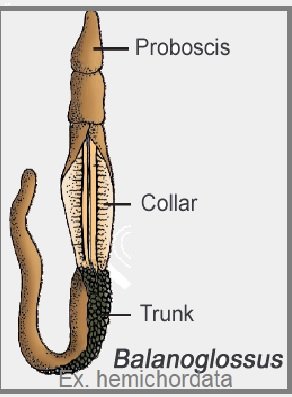Phylum-Hemichordata
Phylum-Hemichordata
These are recently added as a phylum under non-chordates, earlier these were considered as a sub-phylum under the phylum chordates. They possess a rudimentary structure in the collar region known as a stomochord, which is similar to a notochord in structure.
The hemichordates are marine deuterostome animals, generally considered the sister group of echinoderms. They appeared in the lower middle of the Cambrian.
Scientific classification of phylum hemichordate
| Scientific classification of phylum hemichordata | |
|---|---|
| Kingdom: | Animalia |
| Subkingdom: | Eumetazoa |
| Clade: | ParaHoxozoa |
| Clade: | Bilateria |
| Clade: | Nephrozoa |
| Superphylum: | Deuterostomia |
| Clade: | Ambulacraria |
| Phylum: | Hemichordata |
Characteristics features of phylum- Hemichordata
Hemichordates possess the following characteristic features:
- These are a small group of worm-like animals.
- These animals are marine.
- level of organization: The organ system level
- Symmetry: Bilateral symmetry
- Germinal layer: These members possess a triploblastic body.
- Body cavity: coelomate animals.
- These consist of the body in a cylindrical shape, anterior proboscis, a collar, and a long trunk.
- Circulatory system: The hemichordates consist of an open type of circulatory system.
- Excretory organ: The probosci’s gland functions as an excretory organ.
- Reproduction: sexes are separate
- External fertilization is found in hemichordates.
- Development is indirect.
- Some examples of hemichordates: are Balanoglossus and Saccoglossus, Spengelia, Protoglosus, etc.

hemichordate
Classification of Phylum-Hemichordata
The phylum Hemichordata includes two main classes: Enteropneusta (acorn worms), and Pterobranchia.
Class: Enteropneusta (acorn worms) or tongue worm
The enteropneusts shows the following features:
- Most acorn worms range from 9 to 45 cm in length.
- The largest species is Balanoglossus gigas, length 1.5 meters (5ft) or more.
- The body is made up of three main parts:
- An acorn-shaped proboscis
- Short fleshy collar
- A long worm-like trunk.
- The mouth is located at the collar behind the proboscis.
- The skin is covered with cilia and glands. The glands secret mucus.
- Some of them produce a bromide compound that provides a medicinal smell for protection from bacteria and predators.
- Many acorn worms are detritus feeders, eating sand or mud and extracting organic detritus. Others feed on organic material suspended in the water, which they can draw into the mouth using the cilia on the gill bars
- The acorn worm breathes about the same way as fish.
- These possess an open circulatory system.
- Asexual reproduction is not found in them.
- In Acorn worms absence of eyes, ears, or other special sense organs, except for the ciliary organ in front of the mouth, which appears to be involved in filter-feeding and perhaps taste.
- Acorn worms have a Y-shaped nuchal skeleton that starts their proboscis and collar on their ventral side. The length of the horns of the nuchal skeleton varies between species.
Class- Pterobranchia
Class pterobranchia shows the following features:
- These are small worm-shaped animals
- They live in secreted tubes on the floor of the ocean
- Pterobranchia feeds by filtering plankton out of the water with the help of cilia attached to tentacles.
- Proboscis shield-like and gill slit one pair or absent.
- Asexual Reproduction by budding (Sexes are separate, and one pair of gonads are found.)
You may also read:
Click here→Read about Blanoglossus
- Phylum Porifera
- Phylum Coelenterata
- Phylum Ctenophora
- Phylum Platyhelminthes
- Phylum-Annelida
- Phylum-Arthropoda
- Phylum-Mollusca
- Phylum-Echinodermata
- Phylum-Chordata
(source-https://en.wikipedia.org/wiki/Hemichordate#Classification)
Thank you 🙂



6 Comments
Blanoglossus - PCSSTUDIES - Biology Blanoglossus · August 9, 2021 at 10:48 pm
[…] water-dwelling acorn worm (Enteropneusta). Blanoglossus cannot survive in freshwater. It belongs to hemichordates. it is an “evolutionary link” between invertebrates and […]
Balanoglossus - PCSSTUDIES - Biology Balanoglossus · August 10, 2021 at 7:19 am
[…] water-dwelling acorn worm (Enteropneusta). Blanoglossus cannot survive in freshwater. It belongs to hemichordates. it is an “evolutionary link” between invertebrates and […]
Animal kingdom - Classification PCSSTUDIES - Biology - · December 22, 2021 at 7:39 am
[…] Hemichordata […]
Herdmania- Sea Squirts - PCSSTUDIES Zoology Herdmania- Sea Squirts · May 7, 2022 at 2:51 pm
[…] Hemichordata […]
Phylum-Echinodermata - PCSSTUDIES - Biology · March 31, 2023 at 8:44 pm
[…] Phylum-Hemichordata […]
Taxonomy - PCSSTUDIES - Biology · November 28, 2023 at 8:17 pm
[…] Hemichordata […]